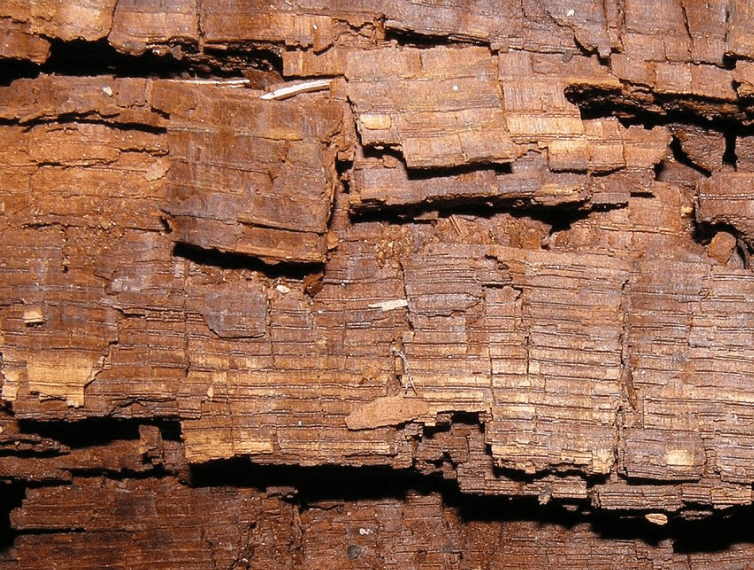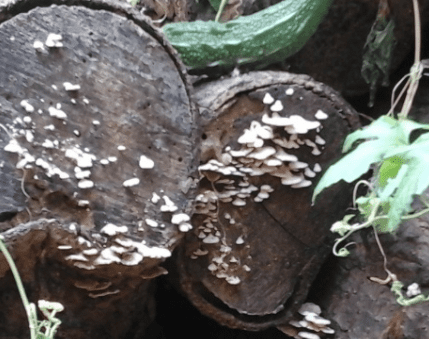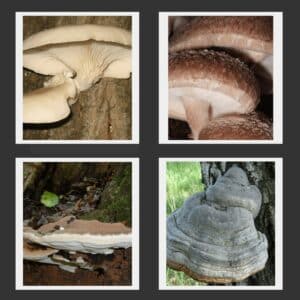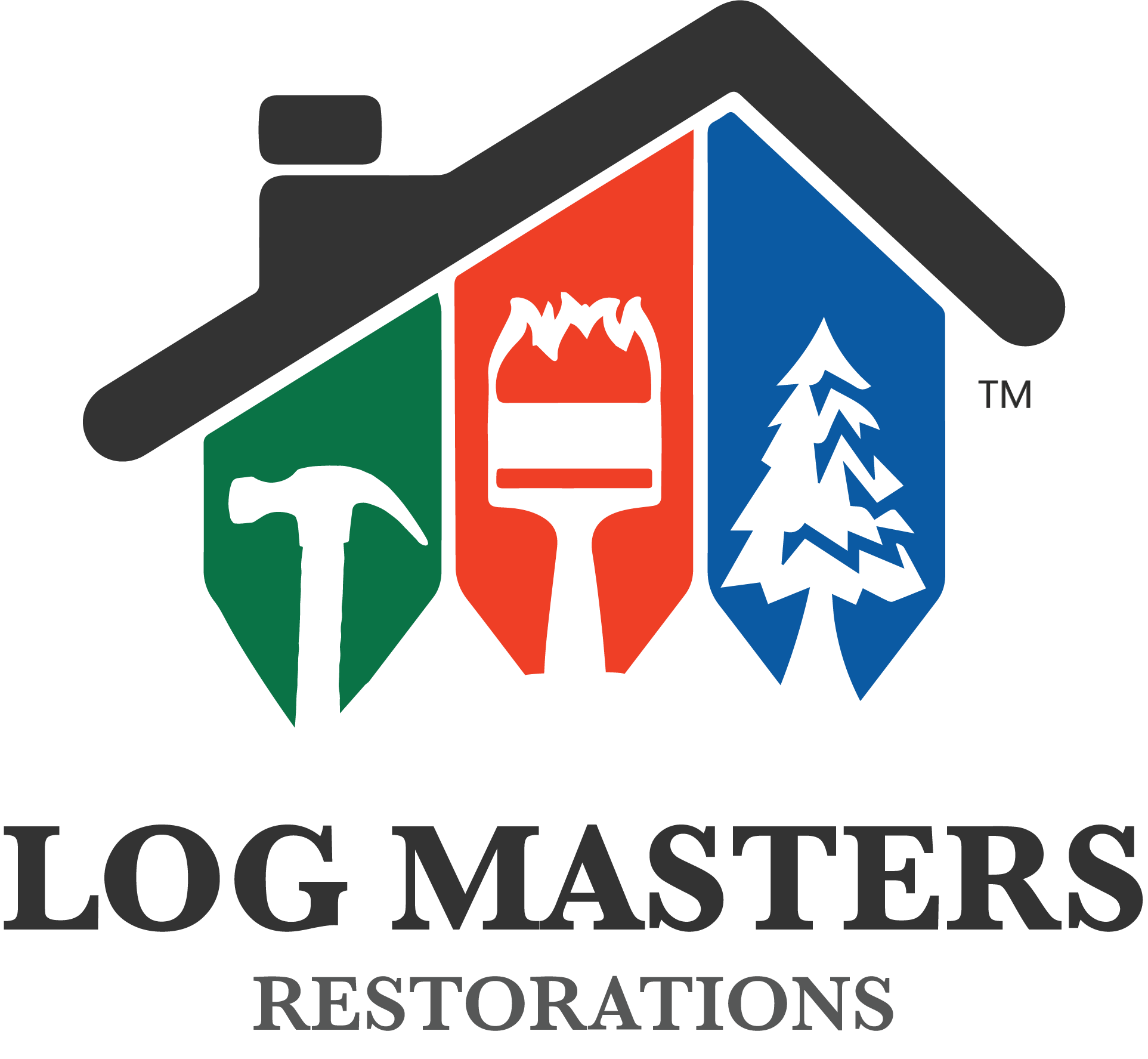Your log home’s worst enemy isn’t wind or rain—it’s something much smaller but far more destructive: rot fungi. These silent invaders weaken your logs from the inside out, slowly turning solid wood into crumbling debris.
Log rot is more than just an eyesore; if left untreated, it can compromise the structural integrity of your home and lead to costly repairs. But by understanding what causes log rot, how to spot it, and how to prevent it, you can keep your cabin standing strong for generations to come.
The Three Types of Log Rot Fungi
Not all rot is the same. Different fungi break down wood in different ways, and identifying which type is attacking your logs is the first step to stopping the damage.
1. Brown-Rot Fungi: The Crumbler

Brown-rot fungi are among the most aggressive wood destroyers, targeting softwoods like pine, spruce, and cedar—common choices for log homes.
How to Spot It:
- Wood becomes dry, brittle, and dark brown
- Crumbles into small cubes or chunks (often called “cubical rot”)
- Affected areas shrink and crack
Where It Happens:
- Logs near the ground or in damp areas
- Under windows and around roof overhangs
- Basements and crawl spaces with poor ventilation
How to Prevent It:
- Keep logs sealed and dry with a high-quality stain
- Ensure gutters and overhangs direct water away from logs
- Fix leaks or drainage issues before rot can spread
2. Soft-Rot Fungi: The Slow Invader
Soft-rot fungi work slower than brown or white rot, but they can attack wood even in extreme conditions—from freezing tundras to humid rainforests.

How to Spot It:
- Wood develops deep grooves or a honeycomb-like structure
- May be mistaken for brown rot due to similar coloration
- Wood softens over time, especially in damp environments
Where It Happens:
- Constantly wet areas (shady sides of the home, around sprinklers)
- Old repairs where moisture has seeped into patched logs
- Historic cabins with untreated wood
How to Prevent It:
- Improve airflow by trimming trees and shrubs near the home
- Regularly inspect for soft spots and apply borate treatments
- Seal logs properly to keep out moisture
3. White-Rot Fungi: The Bleacher
Unlike brown rot, which breaks down cellulose, white rot attacks lignin, leaving wood pale, stringy, and spongy.

How to Spot It:
- Wood appears bleached or lighter than the surrounding logs
- Feels spongy or fibrous, not brittle
- May have mushroom-like fungal growths
Where It Happens:
- Prefers hardwoods like oak and birch
- Rotten deck posts and log corners exposed to rain
- Areas with high humidity and frequent rain
How to Prevent It:
- Apply borate treatments to prevent fungal growth
- Inspect decks and log corners regularly for soft spots
- Re-stain logs every 3-5 years to keep moisture out
Where Does Log Rot Start? Key Problem Areas
Certain areas of your log home are more vulnerable to rot than others. If you know where to look, you can stop the rot before it spreads.
Window Seals and Ground-Contact Logs
Windows are one of the most common places where log rot begins. Poorly sealed windows allow rainwater to seep into the logs, creating the perfect environment for fungi to grow. Likewise, logs that touch the ground absorb moisture from the soil, accelerating decay. Regularly check window seals for gaps or cracking and ensure any logs near the ground are properly treated and elevated whenever possible.
Sprinkler Systems and Nearby Water Sources
Water is the leading cause of log rot, and sprinkler systems that spray directly onto logs can create a long-term moisture problem. Over time, repeated exposure weakens the wood, leading to fungal growth. Make sure your sprinkler heads are adjusted to spray away from the house and check for leaks in hoses or irrigation lines near your foundation.
Minimal Overhangs and Damaged Gutters
If your home has short overhangs or a faulty gutter system, rainwater can easily reach the logs, increasing the risk of rot. Without proper drainage, logs will remain damp long after a storm. Keep gutters clean and in good repair, and if your overhangs are too short, consider installing rain diverters to help channel water away from the logs.
Dense Shrubbery and Poor Airflow
Planting bushes, vines, or other landscaping too close to your log home can trap moisture against the wood, encouraging rot. North-facing walls are particularly vulnerable because they receive less sunlight and take longer to dry. To prevent moisture buildup, keep vegetation at least two feet away from the walls and ensure air can circulate freely around the home.
Pro Tip: North-facing walls stay damp longer than other sides of the home, so inspect them more frequently for early signs of decay.
Regular Inspections and Maintenance
Rot spreads downward as water follows gravity. Catching it early is critical to preventing costly repairs. Here’s what to check:
- Tap logs with a screwdriver—if they sound hollow, investigate further.
- Look for soft spots or cracks—especially in corners or near doors and windows.
- Watch for mushrooms or fungal growth—these indicate deep decay.
- Check your chinking and caulking—gaps can let in moisture.
If you find signs of rot, act fast. Minor rot can often be treated with a borate solution, but advanced decay requires professional repair.
Why You Should Hire a Log Home Inspector
Most traditional home inspectors aren’t trained to evaluate log homes properly. Log cabins require specialized knowledge, and hiring a certified log home inspector can save you thousands in hidden damage.
What a Log Home Inspector Looks For:
- Signs of hidden rot and decay
- Gaps or chinking failures that allow moisture in
- Areas where logs are absorbing too much water
- Structural weaknesses caused by wood breakdown
How to Find One:
Look for inspectors certified by InterNACHI or log home restoration specialists like Log Masters.
Protecting Your Log Home for Generations
Log rot isn’t inevitable—with proper maintenance and regular inspections, you can prevent decay and preserve the beauty of your log home.
- Maintain a strict stain and sealing schedule (every 3-5 years).
- Keep logs dry with proper overhangs, gutters, and landscaping.
- Monitor high-risk areas and catch rot before it spreads.
- Consult log home professionals for inspections and repairs.
Need expert log rot repairs? Contact Log Masters for a free consultation and keep your log home strong for years to come.
